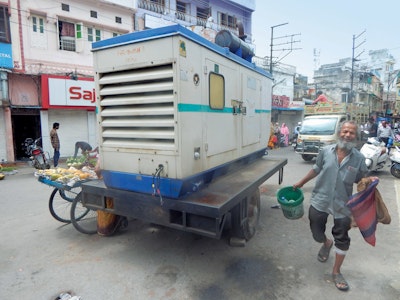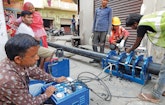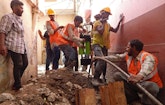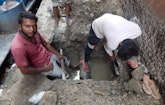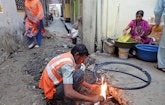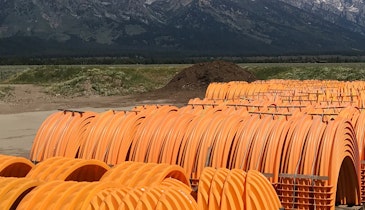
John Rafferty, director of marketing and technical support for TRIC Tools, directs a pipe bursting project in a narrow alleyway of Udaipur, India’s ancient Silawatwari district. (Photography Courtesy of John Rafferty)
Interested in Rehab/Relining?
Get Rehab/Relining articles, news and videos right in your inbox! Sign up now.
Rehab/Relining + Get AlertsUdaipur, one of India’s oldest and most densely built urban areas, was suffering the aftermath of annual monsoon seasons. Sanitary sewer overflows were commonplace.
Like in many of the country’s centuries-old metropolises, streets are excessively narrow, sanitary infrastructure is way past its life expectancy and population has grown so that capacity of existing systems is insufficient. These factors led to the selection of one of Udaipur’s oldest neighborhoods — the Silawatwari district — as an ideal candidate for pipe bursting of its sanitary sewer lines to increase capacity and mitigate SSOs that were commonplace during annual monsoon rain events.
In 2015, India declared the Smart Cities Initiative, a series of projects that would take 100 older cities and upgrade their infrastructure to be more citizen-friendly and sustainable. Sanitation infrastructure would receive high priority under the initiative, and its goals would be achieved through the location and implementation of technologies that could rehabilitate and/or extend the capacity of existing sanitary collections systems.
Unifying all the various municipal and state bodies for the undertaking of the Smart City projects across 100 cities was no small undertaking. Because of this, all the projects are tendered by a central body agency. The ancient city of Udaipur was one of the first cities selected for the initiative.
Only a few large infrastructure engineering and consulting firms in India would be able to meet the requirements for the scope of work on the Udaipur project. Larson & Toubro (L&T) was selected, and it was quick to sub-contract critical elements to small vertically specialized contractors.
During the course of the project assessment, L&T had determined that trenchless technology would be the most effective solution for the Udaipur sanitary system rehabilitation and capacity upgrades. History had already proven that traditional dig-and-replace methods, which had been tried by the municipality 15 years prior in this neighborhood, had provided little positive impact for the community. The scope of the project would impact approximately 80 to 100 dwellings that housed over 1,000 residents, with the goal being to upsize the existing system capacity and eliminate SSOs that were common for the area. Due to this, pipe bursting presented itself as the best fit.
Gearing up
KMV, the local contractor selected by L&T to work with it on the project, had extensive experience with trenchless technology, and pipe bursting in particular. KMV had already begun bursting sewer mains in Udaipur, but the large and heavy equipment it was using on open roadways and plazas simply would not fit in the labyrinth of narrow alleys of Silawatwari and the other ancient parts of town. KMV reached out to Rajeev Oberai of RAUK Consultants and Engineers in Delhi. RAUK had established a distributor relationship with TRIC Tools almost a decade earlier at the 2010 No-Dig Delhi trade show.
While the three basic TRIC pipe bursting units — the X30, the M50 and the M100 — all operate in the same way, each has a different size and capacity. It was determined that the best configuration would be to combine the TRIC M100 puller and its large 1 1/8-inch cable with the smaller M50 plate and wheelbase.
Once the configuration was built and shipped, arrangements were made for a member of TRIC Tools to be present at the project site to train the installation teams. John Rafferty, director of marketing and technical support, was sent to Udaipur to train and familiarize KMV personnel and the engineers with the TRIC method.
A different approach for the hydraulic power pack was needed because of the environment and electrical current (power voltages) used in India, but these special needs brought some surprising advantages.
“Our hydraulic power pack was sourced locally, in Delhi,” Rafferty relates. “Hydmark Applicon, the firm that made it for us, powers its pumps exclusively with electric motors, rather than using gas or diesel engines. Electric motors are strong, reliable and far simpler than fuel-powered engines. To power our pump, we had a massive diesel generator — almost the size of a food truck — stationed at the outskirts of the work area. However, India’s 240V current meant we didn’t need a heavy cord to carry the current long distances which made logistics of power supply through this job site much simpler.”
Additionally, the project site was comprised of numerous narrow alleyways, some barely 2 meters wide, that did not have a standard pattern or configuration, nor the space needed for deploying the typical equipment required. Because of this, the power pack was set up with a 100-gallon reservoir and hose extensions. The unit was approximately the size of two portable restrooms side by side, and it was wheel-mounted so crews could move it to each bursting site.
“I was intrigued by the idea of using an electric power pack for the hydraulics. In a challenging environment such as this, it made sense from a reliability standpoint. For example, in an emergency, replacing a hydraulic power pack specifically suited to your equipment might be difficult, but finding a replacement generator would be relatively easy, so downtime risks could be almost entirely eliminated,” Rafferty says.
Getting up to speed
Day One of the project brought some unexpected challenges, but Rafferty and the crews got inventive. TRIC rep Rajeev Oberai was scheduled to be liaison for Rafferty and act as interpreter for the initial training, but his arrival from Delhi was delayed. As a result the work was conducted in a way that was a bit unconventional, culturally speaking.
Infrastructure contracting firms in India have a definitive hierarchy and crew members do not, as a rule, cross-train or perform tasks other than what has been assigned. In this case, the crew members assigned did not speak English and Rafferty had no knowledge of Hindi. Smartphones and Google Translate helped slightly but effectively training those responsible for the project’s success required Rafferty to get down in the dirt and train by hands-on demonstration, knowing that working side-by-side with the team was the only solution.
Sanitary collections systems in India — at least those in old Udaipur — are designed very differently from those in North America and Europe. The major differences being that only toilet water is discharged to the sewer lateral, and these laterals
connect to the system at the manhole like spokes on a wheel, with the gravity mainline running manhole to manhole with no connections in between. Graywater from each residence is released to shallow trough-like gutters that run along the curb at the front of the buildings.
Manholes in the Udaipur project zone were shallow, built on the spot using hand-mixed concrete and troweled by hand with very thin walls and bases. This meant bursting could be performed on the sewer lines in a straight shot, from the entry point through all the manholes in between with relative ease. Repairing or even rebuilding the manholes could be done immediately and thus not impede quick return-to-service of the mainline segment.
Rafferty was on hand to train the crews and perform the first five pipe bursting pulls on the project. Two of the bursts were short with the remaining three being in the range of 114 feet each. Much of the support work was done by hand, such as fabricating new manholes and trimming the HDPE sewer main to make those new connections. Crews used a highly abrasive steel wire to trim the pipe, pulling it back and forth like old-fashioned lumberjacks. The result was a quick, exceptionally smooth cut and much cleaner than what could be achieved with a motorized saw.
“The simplicity of some of the hand tools and methods used was interesting and amazingly efficient,” Rafferty says. “Some of what I observed were things that I’d like to introduce to our U.S. clients to consider implementing. What we might consider ‘low-tech’ was often more efficient than our fancy electric or computerized tools.”
Great appreciation
Throughout the project, the cooperation and interest of the neighborhood’s residents was outstanding. The work site created disruption to normal foot traffic and mobility, but the community just worked around it and dealt with what would have been considered unsafe by Western standards. Locals would often linger at the project sites observing the work with great interest, and although there was mess and inconvenience, the residents didn’t complain. Instead they expressed great appreciation for the efforts being made to improve the area.
The little neighborhood was returned to its routine within 60 days, with the capacity and condition of its sanitary system greatly improved. This project and the individuals involved are a great example of how Eastern and Western ingenuity and cooperation can create long-term, sustainable solutions for India’s most challenging aging infrastructure issues and help it attain the Smart City Initiative’s goals.
